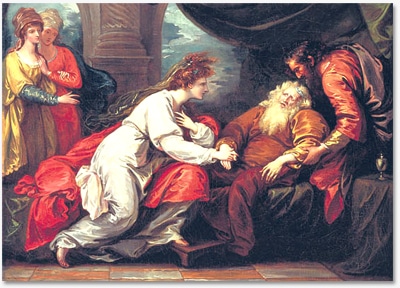In Shakespeare’s play King Lear, Shakespeare introduces many themes. The most important theme shown in King Lear is the theme of madness. During the course of this play, madness is shown in the tragic hero, King Lear. King Lear develops madness right at the beginning of the play but he actually shows it in Act 4. In this act, King Lear is not only at the peak of madness but it is also shown him coming out of his madness as well.
This act is likely to be the most important act because it shows the phases King Lear goes through, from complete madness to him coming out of his madness and realizing his mistake, the point of tragic vision.
The theme of madness in King Lear is first shown in the act through Cordelia’s statement to the guards about the condition her father is in. Cordelia says “Alack, ’tis he! Why, he was met even now as mad as the vexed sea, singing aloud, crowned with rank fumiter and furrow-weeds, with hardocks, hemlock, nettles, cuckoo-flowers, darnel, and all the idle weeds that grow in our sustaining corn.” [Act iv, iv, 1-6]. This gives a great description of King Lear’s state of mind.
Cordelia gives a description of King Lear dressed in flowers, and weeds, and she explains to the guards that he is singing aloud. All of these characteristics are unfit for a king, thus, leaving one reasonable explanation of him being mad, which Cordelia states in her speech to the guards. King Lear’s madness is further illustrated in act 4, scene 6. Although King Lear had shown signs of madness in other acts such as 3, he had really shown the extreme of his madness in this scene. King Lear is shown completely insane, through his garments and his speeches to Gloucester and Edgar.
In one of his speeches, King Lear makes comments about a mouse and a bird that are not present. “..Look look, a mouse! Peace, peace; this piece of toasted cheese will do it…O, well flown, bird!” [iv, vi, 88-91]. This statement was the first sign of him being mad. At the beginning of Act 4, it was just mentioned that King Lear was gone mad, this was the first sign of proof that he was indeed mad. Although King Lear shows signs of being mad, he also shows signs of being sane.
This is shown through him knowing the cause of him being mad. If King Lear was completely mad he would not be able to justify the reason for his madness. In [iv, vi, 96-105] he states that his daughters’ have done him wrong and shows signs of insanity when he calls Gloucester Goneril. “Ha! Goneril with a white beard? They flattered me like a dog and told me I had white hairs in my beard ere the black ones were there. To say ‘Ay’ and ‘no’ too was no good divinity…Go to, they are not men o’ their words! They told me I was everything. ‘Tis a lie- I am not ague-proof.” This quote shows Lear’s sanity. Lear may have qualities in him to make him seem mad but he possesses sanity, enough to know the cause of his madness.
This possession of sanity soon brings King Lear to his moment of tragic vision. King Lear’s moment of tragic vision comes when he is rescued by Cordelia and wakes up in her presence. At first King Lear shows signs of sanity through his speech to Cordelia and Kent about his recognition of him being mad. ” I feel I am not in my perfect mind.” [iv, vii, 63] King Lear then recovers enough to know that he is in the presence of his daughter Cordelia, which he did not know before.
“Do not laugh at me; for (as I am a man) I think this lady to be my child Cordelia.” [iv, vii, 67-69]. The phase of the end of King Lear’s madness is when he finally admits he was wrong and asks for forgiveness. “Pray you now, forget and forgive. I am old and foolish.” [iv, vii, 84]. This is the moment of tragic vision or demonic epiphany because King Lear confesses to his mistake but it is too late because he has already lost everything.
But in order for King Lear to finally admit to his mistakes, he has to be sane. A person has to be in a clear state of mind in order to come up with the notion that they have done something wrong and being a King with such hubris, to admit that they have done a mistake. To conclude, Act 4 was an important act in King Lear. This is because it showed all three phases of madness that the King had gone through.
The phase of him being mad, which was shown through his garments and hallucinations, the phase of him coming out of his madness, by knowing the means of his madness, and lastly the phase of him overcoming his madness, shown through his tragic vision.

